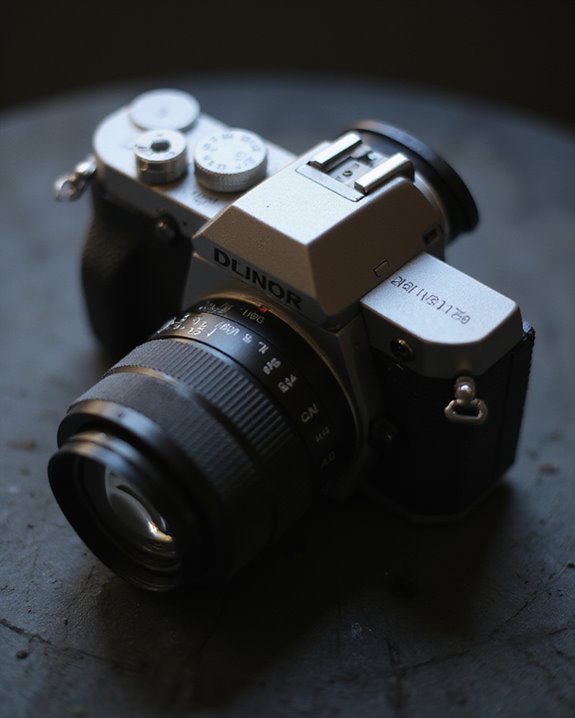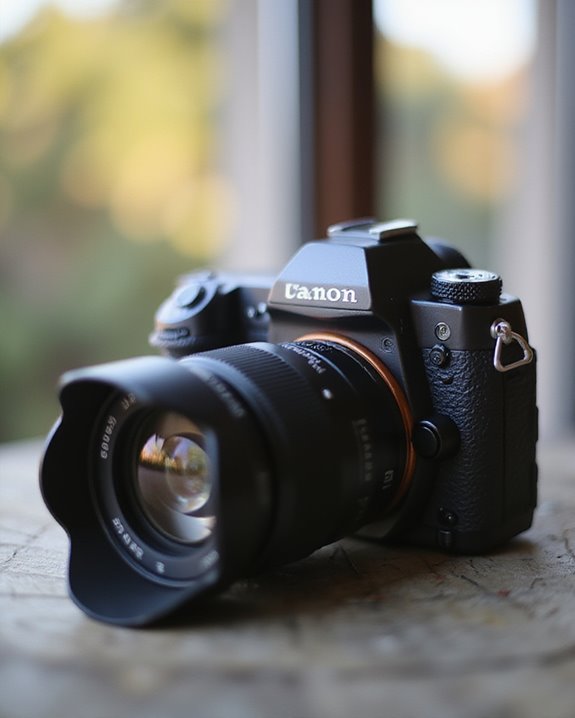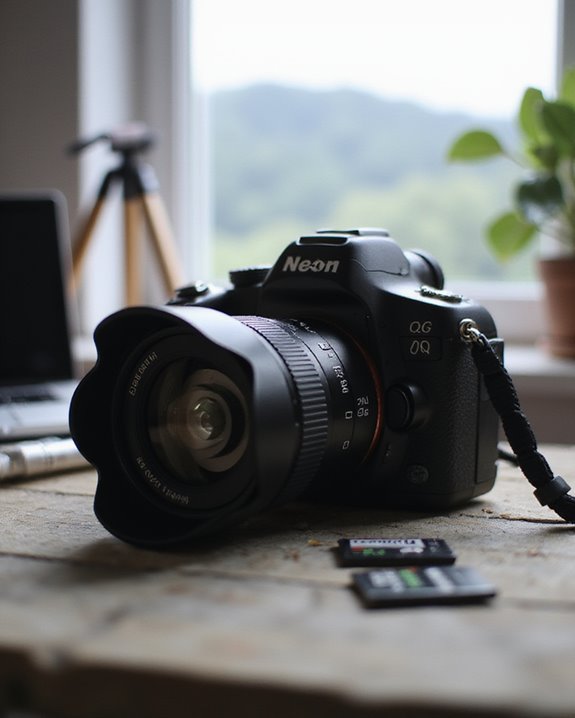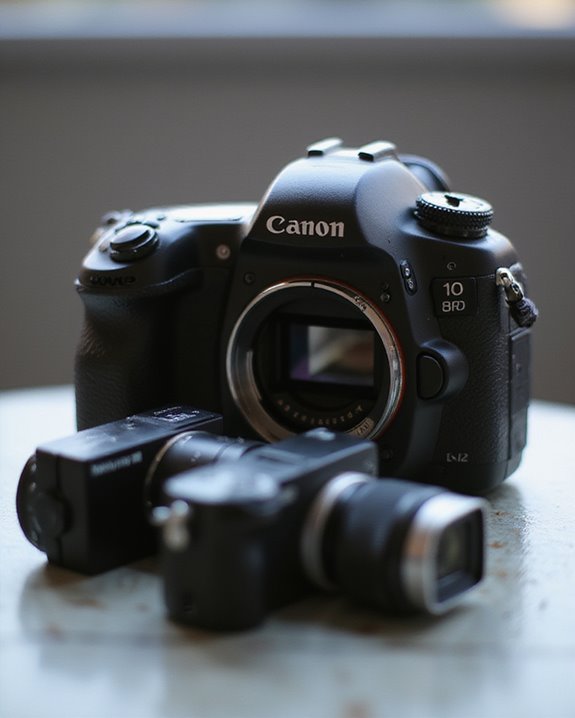A Digital Single Lens Reflex (DSLR) camera combines traditional SLR mechanics with digital imaging technology. We recognize DSLRs by their distinctive reflex mirror system, which reflects light from the lens to an optical viewfinder through a pentaprism, then flips up during exposure to allow light to reach the digital sensor. DSLRs feature larger image sensors, interchangeable lenses, manual controls, and superior low-light performance compared to point-and-shoot cameras. The following sections explore how these sophisticated tools revolutionized photography for professionals and enthusiasts alike.
Key Takeaways
- A DSLR camera uses a mirror and pentaprism system to direct light from the lens to an optical viewfinder.
- These cameras feature interchangeable lenses ranging from wide-angle to telephoto for versatile shooting options.
- DSLRs contain larger image sensors (APS-C or full-frame) that capture superior detail and perform well in low light.
- They provide extensive manual controls for aperture, shutter speed, and ISO settings alongside fast autofocus systems.
- DSLRs typically offer better battery life, weather sealing, and robust build quality than other digital camera types.
Understanding DSLR Camera Technology and Design
A Digital Single-Lens Reflex (DSLR) camera represents one of photography’s most sophisticated technological achievements, combining precision optics with digital imaging capabilities. The defining characteristic of these cameras lies in their Mirror Operation, where a reflex mirror directs light from the lens to an optical viewfinder via a pentaprism, flipping upward during exposure to allow light to reach the digital sensor. This mechanical process distinguishes DSLRs from their mirrorless counterparts.
Sensor Evolution in DSLRs has progressed from early APS-C formats to full-frame sensors that match 35mm film dimensions, dramatically improving image quality, dynamic range, and low-light performance. These cameras maintain the ergonomic advantages of their film predecessors while incorporating modern digital storage on memory cards, electronic controls, and extensive lens compatibility—offering photographers a powerful tool with exceptional versatility across various shooting conditions.
Key Features and Capabilities of DSLR Cameras

The impressive arsenal of features found in modern DSLR cameras provides photographers with unprecedented control and versatility in the field. These devices utilize larger image sensors than compact cameras, delivering superior image quality with more detail and dynamic range. In low light conditions, DSLRs excel due to their advanced sensors and adjustable ISO settings, allowing for clean images even when ambient illumination is minimal. Many professional models incorporate weather sealing, protecting internal components from dust, moisture, and other environmental hazards that might damage less robust equipment. Additionally, the availability of interchangeable lenses enables photographers to tailor their gear to specific shooting scenarios, further enhancing their creative options.
DSLRs offer extensive customization through manual controls for aperture, shutter speed, and ISO, while their pentaprism or pentamirror viewfinders provide accurate image previews. With fast autofocus systems, extensive file format support, and compatibility with interchangeable lenses, these cameras remain the tool of choice for many serious photographers.
The Advantages of Using a DSLR for Photography

Digital photography enthusiasts and professionals alike gravitate toward DSLR cameras for their exceptional performance advantages, which greatly elevate image quality across diverse shooting conditions. We find DSLRs particularly valuable during Outdoor Adventures, where their weather-sealed construction, extended battery life, and superior low-light capabilities allow for uninterrupted shooting in challenging environments. The larger sensors capture more light, greatly reducing noise in dimly lit scenes, while customizable focus settings with multiple focus points guarantee sharp images of fast-moving subjects. Additionally, DSLRs often support superior autofocus systems with multiple focus points, ensuring precise subject tracking in dynamic situations. For Artistic Expression, the interchangeability of lenses—from ultra-wide to telephoto, macro to fisheye—provides unprecedented creative control. DSLRs’ precise manual focus capabilities and accurate optical viewfinders deliver true-to-life framing, while their robust ergonomics reduce fatigue during extended shooting sessions, allowing photographers to concentrate on composition rather than equipment limitations.
Common Applications and Use Cases for DSLRs

Professional photographers rely heavily on DSLRs across diverse photographic disciplines, where the cameras’ technical versatility makes them indispensable tools for capturing exceptional images in specialized scenarios. In action photography, we utilize high-speed continuous shooting at 5+ fps with telephoto lenses (70-300mm+) to freeze decisive moments, while portrait work benefits from wide-aperture primes (f/1.4-f/2.8) for compelling depth-of-field effects. For Artistic Expressions in low-light environments, full-frame sensors deliver superior ISO performance (3200-6400), particularly when paired with fast lenses. Wildlife photographers appreciate silent shutter modes and weather-resistant bodies in challenging field conditions, while Documentary Projects demand dual memory card slots for backup security and the flexibility of RAW capture. Wedding photographers switch seamlessly between wide-angle (24mm) and zoom (24-70mm) setups to document every vital moment. Additionally, understanding the sensor details such as APS-C or full-frame sizes helps photographers choose the right camera for their specific needs and environment.
Comparing DSLRs to Other Camera Types

When examining the landscape of modern photography equipment, we’re often confronted with a critical decision between DSLRs and their increasingly popular counterparts, mirrorless cameras. The Mirrorless Comparison reveals significant differences: while DSLRs offer optical viewfinders, extensive lens compatibility, and superior battery life, mirrorless systems counter with compact form factors, advanced autofocus capabilities, and superior video functions, including 4K recording. DSLRs maintain advantages through their established ecosystems, operational familiarity, and reliable performance in professional settings. In the context of Smartphone Rivalry, DSLRs provide substantially greater image quality and creative control, though they can’t match the convenience and connectivity of mobile devices. Market trends indicate a gradual shift toward mirrorless technology, with manufacturers increasingly focusing their lens development and technological innovations on these systems rather than traditional DSLRs.
Frequently Asked Questions
How Long Does a Typical DSLR Camera Last Before Replacement?
We’ve found that camera longevity typically ranges from 5-10 years. Your DSLR’s replacement timing depends on usage intensity—consumer models last 3-5 years, while professional cameras with proper care can serve much longer.
Can DSLR Lenses Be Used on Mirrorless Cameras?
Yes, we can use DSLR lenses on mirrorless cameras with lens adapters. They’ll bridge the mount differences, though you might face some compatibility issues with autofocus speed and certain advanced features depending on your setup.
Are DSLRS Waterproof or Weather-Resistant Without Additional Protection?
No, DSLRs aren’t waterproof—that’s one of the common waterproof myths. While some have weather sealing variations that resist splashes and dust, they’re only weather-resistant, not waterproof, and still need care in harsh conditions.
How Difficult Is It to Clean a DSLR Sensor?
Sensor cleaning is challenging! We find it’s risky because improper dust removal can damage your DSLR’s delicate sensor. We’d recommend starting with air blowers before attempting wet methods or seeking professional help.
Can I Transfer Photos Directly From My DSLR to Phone?
Yes, we can help you transfer photos directly from your DSLR to your phone! You’ve got several options: wireless syncing via Wi-Fi, wired connections using USB adapters, or SD card transfers depending on your devices’ capabilities.





